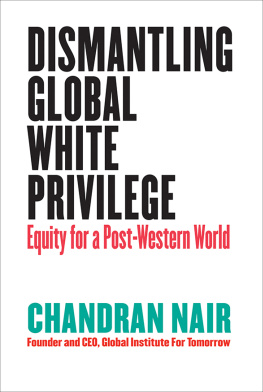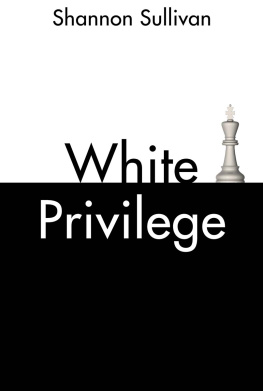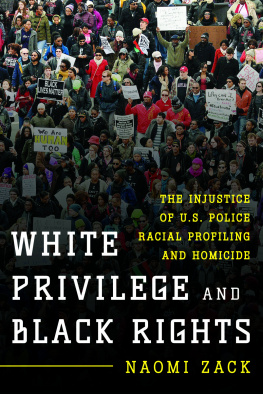Acknowledgments
The writing of this book has benefited from the kindness, time, and backing of so many individuals. Thank you to Charlotte OKelly for your mentorship over the years. Thank you to Rebecca Bach for being a great source of support and wisdom. I thank Kim Blankenship, Linda Burton, Phil Morgan, and Emilio Parrado for your encouragement and helpful skepticism. This project was a large undertaking, and because of your expert feedback and tough questions my research was as successful as it was. And a special thank you to Eduardo Bonilla-Silva. Saying thanks for all of the meetings and emails over the years doesnt seem like enough, but please know I am deeply grateful for your time, insight, and investment in me.
Thank you to the Sociology Departments Race Workshop at Duke University and its vibrant, supportive group of coordinators. Im proud and grateful to have been a part of the community. I would also like to thank Paula McClain, Kerry Haynie, and the Center for the Study of Race, Ethnicity and Gender in the Social Sciences at Duke for including me as a REGSS Graduate Fellow. Thank you to Michelle Christian and Serena Sebring for helping me with my book proposal and to Rose Buckelew for your valuable chapter notes. Thank you to Elizabeth Hordge-Freeman for your support and always insightful annotations. Thank you to Candis Watts Smith (CITB) for your perceptive comments and advice. And to the many people whose friendships sustain me: thank you for the laughs, heart-to-hearts, and companionship.
Thank you to my colleagues at the University of Cincinnati who played an extremely important role in my rewriting and finishing of this book. To my writing groupDanielle Bessett, Erynn Masi de Casanova, and Rina Williamsthank you for your thoughtful and invaluable feedback. Thank you to Jennifer Malat for your astute comments and being a source of support from day one. And a big thanks to my wonderfully encouraging colleagues in the Sociology Department at UC.
Thank you to everyone who worked on this book at the University of North Carolina Press, especially my editor, Joseph Parsons. Thank you for believing in this book and your tireless efforts in getting it published. It was a true pleasure working with you. Thank you as well to the anonymous reviewers for your thorough and insightful feedback. This book has greatly benefited from your time and expertise. I would also like to thank George Mayorga for his patience and work on the featured tables and maps, and thank you to artist Edith Vaca for helping bring Creekridge Park to life.
The study presented in this book was funded by a generous grant from the National Science Foundation. Thank you to the NSF, the proposal reviewers, and the program officers for your support and helpful notes. Thank you to the Charles Phelps Taft Research Center and the Kunz Center for Social Research at the University of Cincinnati for the research support. I would also like to thank Duke Universitys Sociology Department (particularly Ed and Josefina Tiryakian), the Graduate School, and the Latino Studies program (especially Jenny Snead-Williams) for their financial backing. I would also like to thank the Society for the Study of Social Problems and their Racial/Ethnic Minority Graduate Scholarship program. Your support not only helped fund me but gave me a much-needed vote of confidence.
To my Gallo half: thank you Dad, Mom, Amanda, AJ, and everyone for your love and confidence in me. To the MayorgadaDad, Mom, Oscar, Jill, Carla, Roger, Luis, and Georgeyou taught me the importance of social justice and hard work. Thank you for all of the life lessons, love, and championing. And to my most steadfast supporter, Jonathan-thank you for reading, listening, strategizing, and celebrating with me. I am unendingly grateful for you.
Finally, thank you to all of the Creekridge Park residents who took the time to speak with me. I appreciate your candidness during our interviews and your trust in my ability to share your stories. This book, thanks to you, will hopefully facilitate an important conversation locally and nationwide on diversity, inequity, and whiteness.
Behind the White Picket Fence
Chapter 1: Inside Creekridge Park
Creekridge Park is an urban, multiethnic, and mixed-income neighborhood in Durham, North Carolina (see map 1). Temperatures in the low seventies and clear skies made it a perfect day for a picnic. The main purpose of this gathering was holding the CPNA board elections. Burt has a covered garage with a long, wide driveway that served as the party area. The property seems uncharacteristically new and large for the neighborhood. I heard on several occasions from Creekridge Park residents that these happenings are really well-attended. In fact, Cynthia, an established resident and White homeowner in her sixties, stated, We get amazing turnouts.... Its just been phenomenal. The attendance at the annual picnic was highlighted by some respondents and attributed to a location change from a neighborhood-adjacent park to Burts house. It just felt friendly to have it there [at Burts], said Stephanie, a thirty-something White homeowner and established resident.







